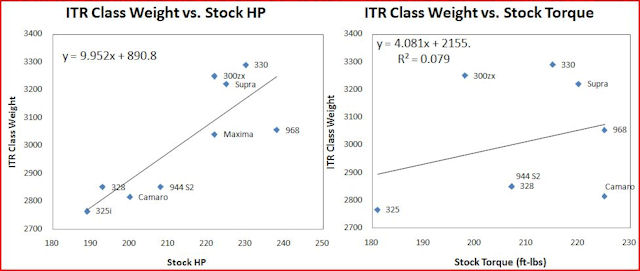The RX8 and V8 conversations in the ITR thread has me thinking again about the "not enough torque to tighten my lugnuts" issue that some cars face, and the impact of that reality on classing/spec'ing IT cars. I'm wondering if maybe we're missing a bet here...
Dynos actually measure torque, right?
Horsepower is a derived value estimate of "work," that considers torque, RPM (for the time factor), and a constant to chase out issues of units. What about the possibility that the Process should actually consider torque instead of HP, perhaps at particular RPM points, or look at where peak torque is in the rev range and consider not only the peak value but the revs at which it occurs...?
We might be able to get away from the subjectivity that gets injected where torque values are out at the ends of the distribution curve - either high or low, well out beyond the mean, since they may be making their peak torque very low, or very high, in terms of revs.
"Oh, but the math might be complicated!" you say. Well, as it is (since the process considers PEAK HP, at just one point on the rev scale), the influence of the location of the torque peak is completely ignored. So yeah, if we want to do a better job of dealing with outliers in an objective, consistent way, then maybe it's worth the extra complexity.
I might also be very confused since my real understanding here is limited to values and manipulating them, rather than the realities that they reflect...
K



 Reply With Quote
Reply With Quote




 Shades of NASA GTS where the average hp and tq to get an artificial number...moved my car to run with ITS and ITR cars.....el toro po po
Shades of NASA GTS where the average hp and tq to get an artificial number...moved my car to run with ITS and ITR cars.....el toro po po 

 C&D etc. gave that up many, many years ago. I think the only magazine that actually dynos the test subjects is Cycle World. I've always found that refreshing and it cuts down on the BS claims from the bike makers. they know they'll be rolling bikes on the CW dynos for tests.
C&D etc. gave that up many, many years ago. I think the only magazine that actually dynos the test subjects is Cycle World. I've always found that refreshing and it cuts down on the BS claims from the bike makers. they know they'll be rolling bikes on the CW dynos for tests.


Bookmarks